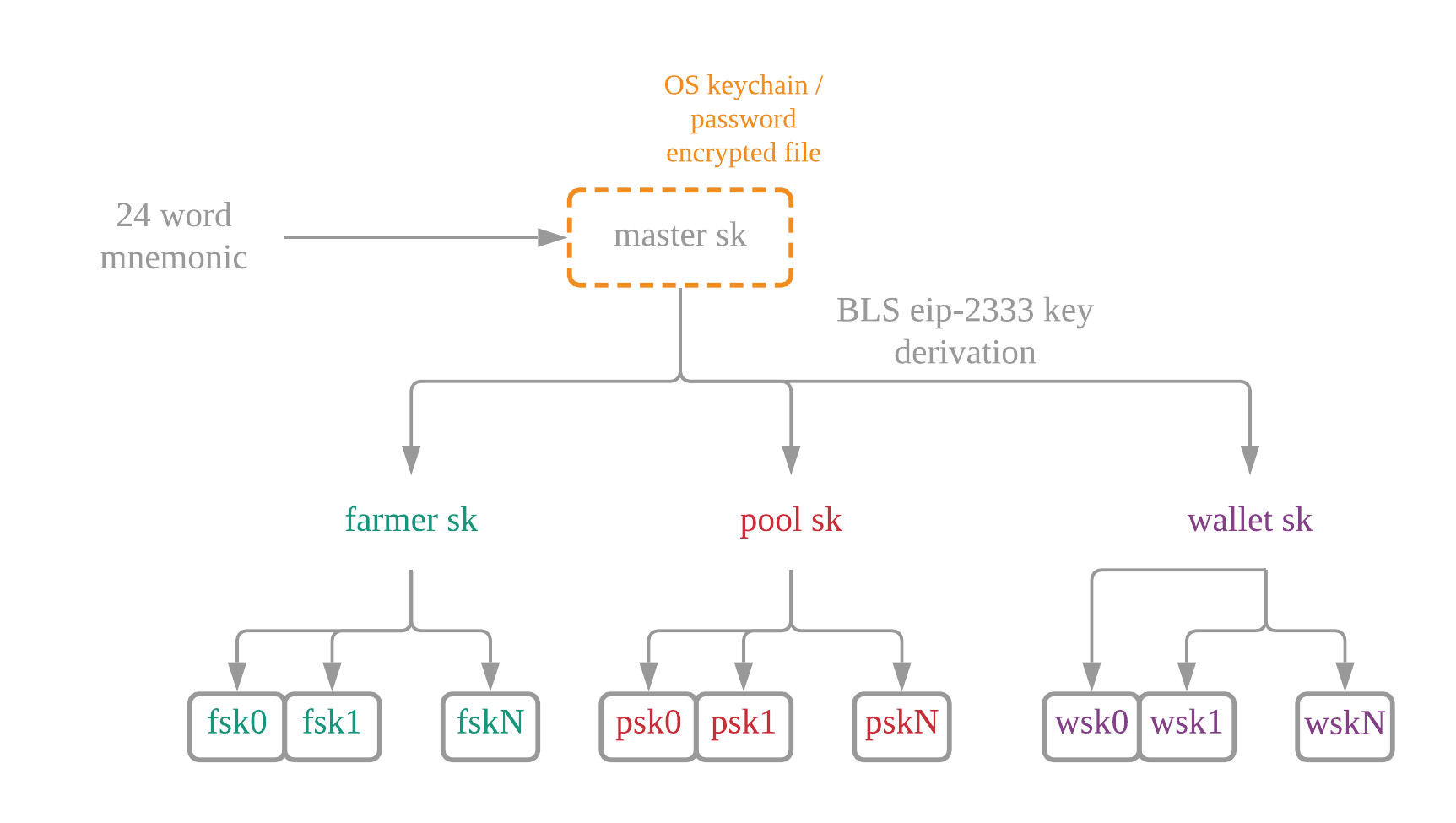9.1 BLS 密钥
BLS Keys
本节将解释奇亚网络中不同类型的密钥。它还将介绍如何生成、存储和使用密钥。这些系统设计得足够灵活,可以支持许多不同的配置和池设置,并且能够抵御各种攻击。
所有奇亚密钥都是 BLS-12-381私钥,遵循 [IETF 规范](https://datatracker.ietf.org/doc/draft-irtf- cfrg-bls-signature/)、EIP-2333 密钥派生规范和 [BIP 44 注册](https://github.com/ satoshilabs/slips/blob/master/slip-0044.md)。私钥 32 字节,公钥 48 字节,签名 96 字节(公钥是 G1 中的点,签名是 G2 中的点。)
警告:奇亚的实现与 EIP-2333 之间存在细微差别,如下一节所述。
BLS 签名允许许多功能和优化,例如非交互式 m/n 阈值、块中所有签名的聚合以及 chialisp 技巧,例如将两个硬币组合到同一笔交易中。私钥可以通过使用 24 个单词的助记词生成,用户可以用它来备份和恢复他们的钱包。
这 24 个字可以与 BLS 私钥相互转换。BLS 主私钥存储在 OS 钥匙串中,通常需要密码验证并进行加密。
主私钥可用于派生子密钥,其还可用于派生子密钥等。级别数可以是无限的。BLS 公钥可以组合成一个新的公钥,用于验证聚合签名。
每次钱包生成一个新地址来接收资金时,它都会创建一个新的 BLS 私钥。农场主和矿池仅使用当前代码库中的第一个密钥,但可以更新它们以在每次赢得区块时生成新密钥,以增加隐私。
当谈到获得报酬时,会创建一个使用钱包 BLS 公钥的 chialisp 程序。该程序称为谜语,经过哈希处理以生成谜语哈希。然后将谜语哈希转换为 bech32m 格式的地址,以方便纠错和可用性。
因此地址类似于钱包子 BLS 公钥,其私钥可以从主种子中导出。

原文参考
This section will explain the different types of keys in the Chia network. It will also cover how the keys are generated, stored, and used. These systems are designed to be flexible enough to support many different configurations and pooling setups and to be resilient to various attacks.
All Chia keys are BLS-12-381 private keys, following the IETF specification, the EIP-2333 specification for key derivation and BIP 44 registered. Private keys are 32 bytes, public keys 48 bytes, and signatures 96 bytes (public keys are points in G1, signatures are points in G2.)
WARNING: There is a slight difference between Chia's implementation and EIP-2333, as described in the next section.
BLS signatures allow for many features and optimizations, such as non-interactive m/n thresholds, aggregation of all signatures in a block, and chialisp tricks like combining two coins into the same transaction. Private keys can be generated by using a 24-word mnemonic phrase, which users can use to back up and restore their wallets.
The 24 words can be converted to and from a BLS private key. The BLS master private key is stored in the OS keychain, which usually requires password authentication and is encrypted.
The master private key can be used to derive child keys, which can further be used to derive child keys, etc. The number of levels can be infinite. BLS public keys can be combined to form a new public key, which can be used to validate aggregate signatures.
Each time the wallet generates a new address to receive funds, it creates a new BLS private key. The farmer and pool only use the first key in the current codebase, but they can be updated to generate a new key every time a block is won, for additional privacy.
When it comes to getting paid, a chialisp program is created that uses one of the wallet BLS public keys. This program, called a puzzle, is hashed to generate a puzzle hash. The puzzle hash is then converted to an address in bech32m format, for easy error correction and usability.
So an address is analogous to a wallet child BLS public key, the private key of which can be derived from the master seed.

奇亚和 EIP-2333 的区别#
奇亚遵循的规范在 IRTF CFRG BLS 标准版本 1 中进行了描述。版本中进行了更改 2 这使得密钥生成不兼容。两个版本都是安全的,但奇亚密钥在 2020 年致力于最终的绘图格式,因此使用旧版本的规范。
原文参考
Difference between Chia and EIP-2333#
The specification that Chia follows is described in the IRTF CFRG BLS standard, version 1. There was a change made in version 2 which makes the key generation incompatible. Both versions are secure, but Chia keys were committed to the final plot format in 2020 and thus the older version of the specification is used.
非观察者与观察者密钥#
有两种方法可以从父密钥派生子密钥:非观察者和观察者(也称为强化和未强化)。
非观察者密钥是 EIP-2333 规范中默认且仅受支持的方法。它们是安全的,因为每个密钥都是加密分离的——泄露一个密钥对其祖先或兄弟姐妹的安全性没有影响。但是,非观察者密钥在功能上受到限制,因为它们只能通过私有派生来派生。也就是说,父公钥可用于派生子私钥,但父公钥不能用于派生子私钥。
观察者密钥确实允许公开派生。这使仅查看钱包支持查看您的所有公钥,仅使用根(主)公钥。这是通常为比特币高清查看钱包所做的。与像以太坊这样的系统相比,它可以实现更多的隐私,它为所有交易重用相同的地址。
HD 密钥的一个优势是税收计算:如果您为每笔交易使用不同的地址,您只需将您的父公钥提供给您的会计师,他可以使用它来导出您所有的子地址。对于非观察者密钥,这是不可能的。
HD 密钥的主要安全缺陷是,如果您不小心泄露了单个子私钥以及父公钥,那么也可以计算出您的父私钥和所有兄弟密钥。
在奇亚于 3 月和 2021 年 5 月启动主网时,仅使用了非观察者密钥。从 2021 年 12 月开始,支持 —— 并且首选 —— 仅查看钱包支持观察者密钥。
原文参考
Non-Observer vs Observer Keys#
There are two ways in which child keys can be derived from parent keys: non-observer and observer (also called hardened and unhardened).
Non-observer keys are the default, and only supported, method in the EIP-2333 spec. They are secure, since each key is cryptographically separated -- revealing one key has no impact on the security of its ancestors or siblings. However, non-observer keys are limited in functionality, because they can only be derived through private derivation. That is, a parent private key can be used to derive a child private key, but a parent public key cannot be used to derive a child public key.
Observer keys do allow public derivation. This enables view-only wallets that support viewing all of your public keys, using only the root (master) public key. This is what is usually done for Bitcoin HD view-only wallets. It enables more privacy when compared to systems like Ethereum, which reuse the same address for all transactions.
One advantage of HD keys is tax calculation: if you use a different address for each transaction, you only need to give your accountant your parent public key, who can use it to derive all of your child addresses. This would not be possible with non-observer keys.
The main security drawback of HD keys is that if you accidentally reveal a single child private key, along with the parent public key, then your parent private key and all sibling keys can be calculated as well.
At the time of Chia's mainnet launch in March and May 2021, only non-observer keys were used. Beginning in December 2021, observer keys are supported -- and preferred -- for view only-wallet support.